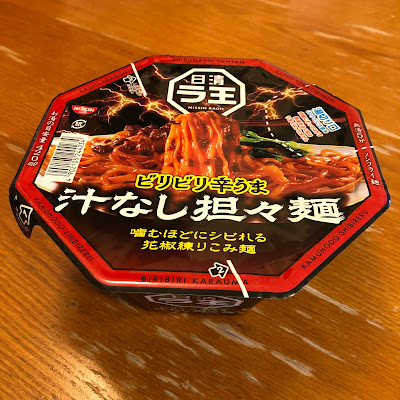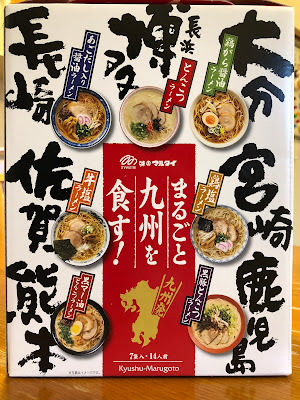The last instant ramen yakisoba I reviewed was the Maruchan Seimen Cup Yakisoba. I'm reviewing the Nissin RAOH Shiranushi Tantanmen noodle bowl this time. This is another yakisoba style instant noodle bowl I picked up at H-Mart at the same time when they were available for a limited time. RAOH is Nissin's line of deluxe instant noodles that are air dried noodles and not fried. They have a superior ramen noodle in terms of texture and chew compared to the regular deep fried noodles. These noodles are carefully crafted to have to simulate fresh noodles better.
Between this RAOH and the Maruchan Seimen variety reviewed last time, I have not had a yakisoba style instant noodle that did not use the regular deep fried noodles like you would find in Nissin's UFO brand of yakisoba. I quite like the UFO yakisoba so this is going to be a treat. The Maruchan was quite good so I'm looking forward to trying this Nissin variety too. I'm figuring this is going to be spicy as it shows lightning and deep red sauce colours on the picture on the lid. As a tantanmen, it is going to have a whole bunch of Sichuan peppercorn in it. By the way, Sichuan peppercorn is not regular pepper and it has a different kind of spicy heat to them.
 |
3/4 view of the typical RAOH instant noodle bowl in the octagonal stop sign design. The bowl is made out of a smoothly finished styrofoam.
|
 |
Top view of the lid of the bowl. It centrally features some spicy looking noodles with little bits of ground meat and some bok choy in the background. There are flashes of lightning racing through the background to let you know it is going to be electric. The RAOH logo is prominently featured in a white octagon.
|
The top of the noodle bowl uses dark and deep colours to give this bowl a little gravity. This is serious stuff folks, not some sunny day part ramen. The dark colours, the reddish sauce on the noodles, and the rich red trim make this noodle bowl look classy and a bit like Japanese lacquerware. Like all yakisoba bowls, pay attention to the the 1, 2, 3 markings on the lid. The 1 indicates where you should peel it back to get at the satchets inside and fill it with boiling water. The 2 indicates how far back you should peel the lid as you only peel it part of the way back. The 3 indicates where you would peel off a panel to drain the water out of the bowl later.
 |
Side of the bowl. White print on black for good contrast. Look at the electric bolts in the background. This shows the ingredients and manufacturers information. The spice and heat levels are at 3 and 4 as you can see from the little octagons off the the right side.
|
 |
Nutritional information. Almost 20 grams of fat, so you know the sichuan sauce is going to be oily and rich as the noodles are air dried and not fried.
|
 |
Directions. It takes 5 minutes for these noodles to rehydrate properly.
|
 |
After opening the lid, you get a sauce packet, and a sachet of dehydrated meat pieces and bok choy.
|
 |
Closeup of the sauce packet and the dried meat and veggies.
|
 |
The dried noodle puck inside the bowl. It looked like typical RAOH noodles.
|
I added boiling water to the noodles after putting in the dried meat and choy to rehydrate along with the noodles. After waiting for 5 minutes I pulled the tab off marked by the three and drained the water out. The noodles were now ready to add in the Tantan sauce which smelled of peppers and peanuts. Tantan or dandan is a spicy peanut sauce from Sichuan province in China and I wondered what this Japanese take on it was going to be like. I mixed the sauce to coat all of the noodles.
 |
Tantan sauce on noodles.
|
 |
The noodles after mixing in the sauce well. Nice orangy-red sauce to let you know it is spicy.
|
I have to say the noodles smelled pretty appetizing between the spice
and the peanuts. The first taste of the noodles in sauce showed that is
was definitely spicy hot in that numbing heat you get from the Sichuan
peppercorns. The heat builds as you eat more of the noodles too. This
was definitely spicy, but not unbearable. The noodles had a good chew
and texture and were a normal ramen noodle. The bok choy and little
bits of ground meat always seem to vanish into the noodles but they
always add a nice little touch to things. I found that this noodle bowl
was good, but that the peppercorns were almost a little too
predominant, drowning out the other flavours. I bought two of these, so
I'm not regretting my purchase, but it isn't one of my favourites.
 |
Closeup of the noodles with some ground meat and bok choy.
|
Follow me on Twitter a @Tostzilla or my feedburner.
More snacks and Japanese pop culture.






















Comments
Post a Comment